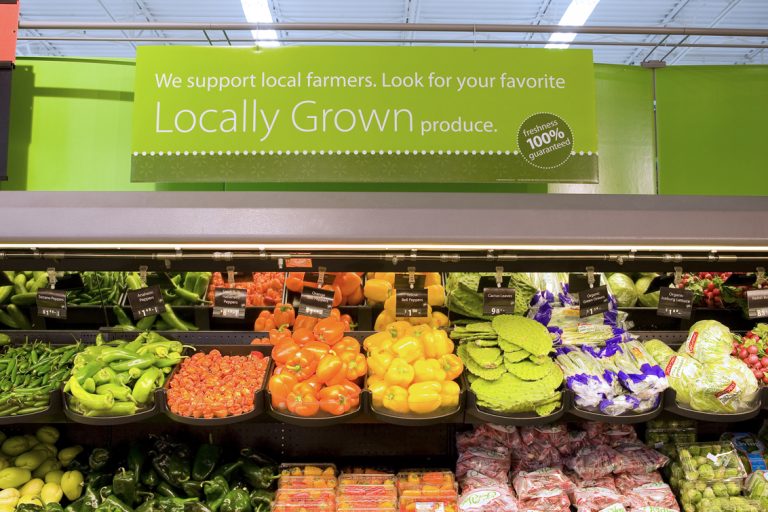3 min read
Written by Marc Xuereb

Stacy Mitchell of the Institute for Self Reliance recently wrote a piece for grist.org about Walmart’s dominance of the grocery sector, and how its entry into the organic and local sectors is bad news. For the full article, comments, and links to previous articles in her series on Walmart, see http://www.grist.org/food/2011-12-30-eaters-beware-walmart-is-taking-over-our-food-system. Here are some excerpts:
It was only 23 years ago that Walmart opened its first supercenter, a store with a full supermarket inside. By 1998, it was still a relatively modest player with 441 supercenters and about 6 percent of U.S. grocery sales. Last year, as its supercenter count climbed above 3,000, Walmart captured 25 percent of the $550 billion Americans spent on groceries.
As astonishing as Walmart’s national market share is, in many parts of the country the chain is even more dominant. In 29 metro markets, it accounts for more than 50 percent of grocery sales.
Seeking an even bigger piece of the pie, Walmart is campaigning to blanket New York, Chicago, Washington, D.C., and other big cities with its stores. It has made food the centerpiece of its public relations strategy. In a series of announcements over the last year, Walmart has deftly commandeered high-profile food issues, presenting itself as a solution to food deserts, a force for healthier eating, and a supporter of local farming.
It is a remarkably brazen tactic. On every one of these fronts, Walmart is very much part of the problem. Its expansion is making our food system more concentrated and industrialized than ever before. Its growth in cities will likely exacerbate poverty, the root cause of constrained choices and poor diet.
What Walmart means when it says “local”
Last year, Walmart announced that it would double the share of local produce it sells, from 4.5 to 9 percent, over six years.
This doesn’t necessarily mean shoppers will soon find a variety of local produce at their nearest Walmart, however. Walmart counts fruits and vegetables as local if they come from within the same state. It can achieve much of its promise by buying more of each state’s major commodity crops, such as peaches in Georgia and apples in Washington, and by using big states like California, Texas, and Florida, where both supercenters and large-scale farming are prevalent, to pump up its national average.
Walmart’s promise to increase local sourcing is reminiscent of its pledge five years ago to expand its organic food offerings. “They held true to their corporate model and tried to do organics the same way,” said Mark Kastel of the Cornucopia Institute. For its store-brand organic milk, for example, Walmart turned to Aurora Organic Dairy, which runs several giant industrial milking operations in Texas and Colorado, each with as many as 10,000 cows. In 2007, the USDA sanctioned Aurora for multiple violations of organic standards. Earlier this year, the agency stepped in again, this time revoking the organic certification for Promiseland Livestock, which had been supplying supposedly organically raised cows to Aurora.
Leveraging food deserts
Walmart has renewed its push to get into big cities, after trying and failing a few years ago. This time the company has honed a fresh strategy that goes right to the soft underbelly of urban concerns. In July, Walmart officials, standing alongside First Lady Michelle Obama, pledged to open or expand as many as 300 stores “in or near” food deserts.
Walmart sees underserved neighbourhoods as a way to edge its camel’s nose under the tent and then do what it’s done in the rest of the country: open dozens of stores situated to take market share from local grocers and unionized supermarkets. Stephen Colbert dubbed the strategy Walmart’s “Trojan cantaloupe.” For example, an analysis by Manhattan Borough President Scott Stringer’s office estimates that if Walmart opens in Harlem, at least 30 supermarkets, greengrocers, and bodegas selling fresh produce would close.
For neighbourhoods that are truly underserved, it seems hard to argue with the notion that having a Walmart nearby is better than relying on 7–11 and McDonald’s for meals. But poor diet, limited access to fresh food, and diet-related health issues are a cluster of symptoms that all stem from a deeper problem that Walmart is likely to make worse: poverty.
